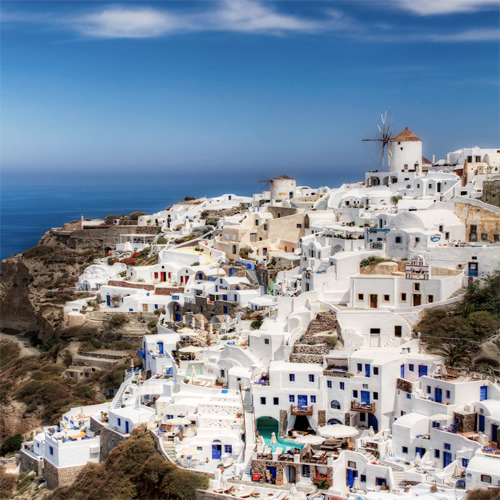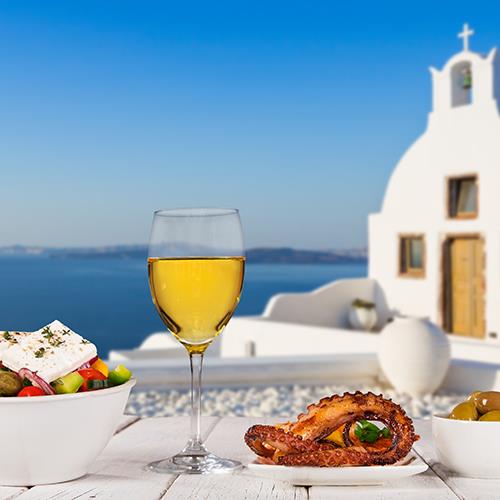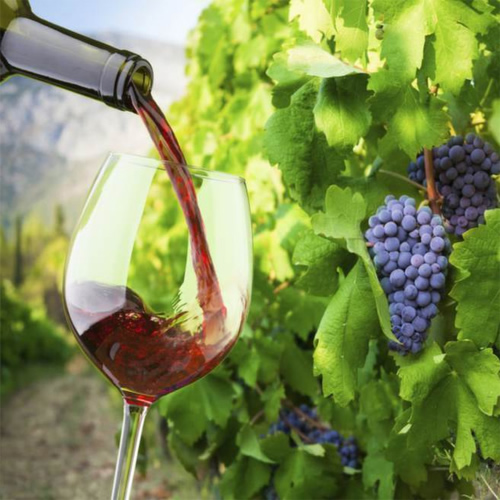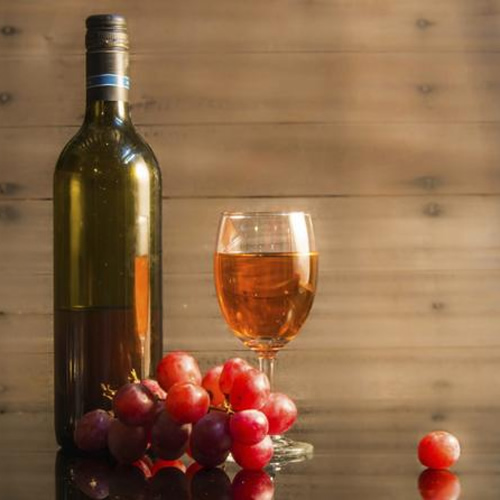Popular Wine Regions of Greece


Santorini Island
The beautiful Cycladic island in the middle of the Aegean Sea with its unique volcanic beauty and great history is also a treasure for wine lovers. With a long winemaking tradition and numerous wineries opened for visitation and wine tastings, Santorini is perfect for wine lovers.
Some of the most important grape varieties of Santorini are the Athiri, Aidani, Mandilaria, Mavrotragano, and the most famous wines of Santorini, Assyritiko. If you’re looking for a place that offers local wines, visit Gaia Wines just beside the airport of Santorini. Gaia Wines are also one of the ten wineries around the world that use the under-sea aging technique.
Another reason to visit Santorini is because of the Koutsoyannopoulos Wine Museum. It is one of the top five wine museums in the world. You can learn a lot of things about wine here from wine varieties to wine production.
And of course a visit to Santorini would not be complete without a visit to one of their fabulous beaches while sipping on your favorite Greek wine at sunset.
For more information on Santorini wines, visit this page.


Rhodes Island
Rhodes, the island of the Knights, is the fourth largest Greek island and was one of the first of the Aegean islands to adopt the cultivation of the grapevine and winemaking process. The island combines medieval and traditional elements, beautiful beaches with pine covered mountains, villages and seaside settlements, archaeological sites, medieval monuments, and cosmopolitan tourist resorts. When it comes to wine, the island has a fine reputation, which holds a long standing tradition. Helped by its strong maritime presence, Rhodes was the biggest wine exporter in the region. The island’s main varieties are Athiri (white grape) and Amorgiano (red grape, often called Mandilaria), together with two Muscats (sweet white wine), the petits grains (small-berried) and the Di Trani. The vineyards of Rhodes are cultivated mainly around Mt. Attavyros.
In 1971, Rhodes earned its right of Appellation of Origin of Superior Quality for white, red and sweet wines as it was one of the few places in Greece where the vineyards were expanded after the Second World War. In Greece, Protected Designation of Origin wines represent 8%-10% of total wine production. In Rhodes, the percentage reaches 90% of total production for grapes, and for wines, it approaches 40% of total production.
Approximately 5,000 acres of vines are grown on the island in two zones and it is considered one of the richest vineyards of Greece, cultivating Greek and international varieties. Each zone, due to differences in microclimate and soil, produce wines of different taste and characteristics. The vineyards of Rhodes, which are cultivated in small plots and scattered areas, have never suffered from phylloxera (a microscopic louse or aphid that lives on and eats roots of grapes), thus many vines are 50-60 years old. The harvest starts in late August and is usually completed in late September, depending on variety and region.


Kefalonia Island
The biggest of the Ionian Islands, Kefalonia is as diverse as it is vast. From the farmland and vineyards of the Paliki Peninsula to the sheer cliffs and rocky shoreline of the north, this island is filled with surprises. Kefalonia also offers some of the best wineries in the country with an extensive winemaking tradition. The island is synonymous with Robola, a grape variety producing white wine. In the past, the Venetians referred to it as the “Wine of the Stone,” because the variety’s vines grew, along with black fir trees, on the rocky hills of Mount Ainos.
These days, the Robola variety is cultivated over large expanses covering the slopes of Mount Ainos, leading all the way down to the coastline. The island prides itself for being the only Robola producer as the variety is not cultivated anywhere else. The Robola is a white wine, with rich flavors of sweet lemon, pineapple, and beeswax, along with a bit of bitterness.
Robola is usually vinified alone, without the addition of any other varieties during the fermentation process, yielding unique and sophisticated wines of a bright gold color, fairly high acidity and refreshing aromas, with hints of lemon blossom, citrus, and Muscat grapes. Robola also produces fascinating results when blended with the abundant varieties found on Kefalonia.
The Moschatela, Muscat and Vostilidi (or Goustolidi) which produce white wines and the red Mavrodafni, are all very interesting, as are other lesser known local varieties.

Crete Island
The largest of the Greek islands, Crete is the birthplace of Zeus and the cradle of European civilization. The island is a fantastic island to visit at any time of the year offering beautiful weather even during the winter months. The southernmost Greek island has beaches, ancient archaeological sites, ancient villages, and numerous nature hikes. Crete also has a long history of wine production, with more than 60 wineries, including several world-class producers and a number of distinctive local grape varieties. It is the second-largest wine-producing region in Greece. Popular varietals here include a dry white wine called Vidiano and an unusual red wine, Liatiko, with notes of rose and cherry.
The majority of vineyards are in the center of the island, south of the port of Heraklion, with other producers in the west around Chania and in the east around Sitia. Consider visiting the Manousakis Winery, near Vatolakkos, Douloufakis Winery, outside Heraklion, and Rhous Winery, producing organic wines amid stunning island scenery in Houdetsi.
Crete has a warm climate but the majority of planting is above 500m, which helps to cool the vines and preserve a little acidity. Dry sandy soil kept phylloxera at bay until the 1970s and there are still many ungrafted vines. Irrigation is common.

Paros Island
Paros is an island in the heart of the Cyclades Islands with over 10,000 inhabitants and 75-miles of coastline. Serene landscapes, fertile valleys and rolling hills are dotted with small churches and monasteries, complemented by endless sandy beaches. The mountain-dominated island and ideal climate conditions of the Cycladic landscape has led to the production of some great wines, red, white and rose. The dominating grape variety here is the Monemvassia. There are many wineries around the island, but Moraitis Winery in Naoussa is one of the most popular.
The coastal town of Naousa (or Naoussa) is home to the Paros Wine and Vine Museum. This exists on wine donations made by local producers keen to educate tourists and promote viticulture in the Aegean Islands. Around a thousand farmers are involved in viticulture here. They produce roughly 660,000 US gallons of wine per year.


Thessaloniki
Thessaloniki is Greece's second-largest city and the capital of the Greek region of Macedonia. The city is famous for its picturesque restaurants and tavernas as well as for its lively nightlife. The vineyards and wineries of Thessaloniki are just as much a part of the city’s cultural identity as the monuments, castles and art deco buildings.
There are wineries within an hour’s drive in every direction of Thessaloniki. These vineyards are part of a network of Winemakers of Northern Greece, a group of wineries committed to advancing the name of Greek wines internationally. To the west, you reach Kalohori, on the outskirts of the bird-rich Axios Delta wetlands, and to the north are the vineyards around Langadas, in the foothills of Mt Ossa. And heading south, you pass the seaside escapes of Perea, Agia Triada and Nea Michaniona to perhaps Thessaloniki’s best-known wine-growing area, Epanomi, on the edge of the Thermaic Gulf. Many have been awarded protected geographical indications (PGI) status.
You’ll visit a winery that has incorporated a museum, Gerovassiliou Wine Museum, into its grounds, check out the collection of corkscrews and wine-growing tools. Touring these vineyards and cellars will give you an appreciation of the first-rate facilities, the gorgeous landscape, among the areas’ rich cultural treasures.


Athens
The birthplace of democracy, the capital of Greece, Athens captures the heart of its visitors. It’s a vibrant city, a center for arts, history, and culture. Many may not know that Athens is surrounded by small historical vineyards that are dotted around the city’s landscape. Dinoysus god of wine and fertility was worshipped and celebrated in ancient times and is said to have given the knowledge of viticulture to Icarius of Athens, more than 3,000 years ago.
Although not as well-known as other wine regions, the Mesogaia valley, a mere 20 miles from Athens, is covered with 650 hectares of vines. The Mesogaia vineyard, defined by Mount Pendeli to the north and Hymettus to the south, has been the capital’s purveyor of inexpensive, everyday wine for centuries.
Also close by, about an hour away from Athens city center, you will find yourself in a historical vineyard close to the Attica coastline. Five notable winemakers of Attica, with a common goal, have joined forces to create Wine Roads Athens. In this winemaking region with a history which spans 3500 years, they cultivate their vineyards with dedication, passion, working with both indigenous and international varieties. Their aim is to produce wines of high quality which express the personality and the distinctive characteristics of their vineyards.
Wines of Athens was created by the need of the winemakers to put the vineyards of Attica and the local grape variety, Savatiano, on the map. Wines of Athens goal is to bring back Retsina, the oldest wine in the world, as well as creating a network connecting the wineries with the abundant archaeological sites of Attica, thus allowing the visitor to take a dream journey through history, enjoying the beauty of the Attican landscape and discovering the wonderful world of Greek wine.


Nafplion
Geographically located on the eastern side of Peloponnese (southern Greece) and only 2 hours drive from Athens, Nafplio is widely considered one of the prettiest and most romantic towns in Greece. The region features a hot Mediterranean climate where oranges grow, that are so low-acid and aromatic that the juice is almost like drinking a fresh-squeezed Sunny-Delight. The dominant wines here are the aromatic white wines along with one ringer, Agiorgitiko, which is Greece’s other top, and most-planted red variety.
When visiting Nafplion, you cannot pass up the opportunity to also visit its fascinating surroundings and get to know the beautiful places the Greek countryside has to offer that are in close proximity. Exploring the wine in this region provides a chance to get acquainted with organic grape farming and balsamic vinegar production.
Agiorgitiko is well known from Nemea, a region in Peloponnese which is most famous for this grape. The red wines are more full-bodied with flavors of sweet raspberry, black currant, and plum sauce with nutmeg and subtle bitter herbs (somewhat like oregano) and smooth tannins. The wines are generous and fruity, similar in style to Merlot, but with slightly more spice. The rosé wines made with Agiorgitiko have wonderful spiced raspberry notes and a brilliant deep pink color.